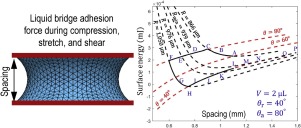当前位置:
X-MOL 学术
›
Colloids Surf. A Physicochem. Eng. Aspects
›
论文详情
Our official English website, www.x-mol.net, welcomes your feedback! (Note: you will need to create a separate account there.)
On Liquid Bridge Adhesion to Fibrous Surfaces under Normal and Shear Forces
Colloids and Surfaces A: Physicochemical and Engineering Aspects ( IF 5.2 ) Pub Date : 2020-02-01 , DOI: 10.1016/j.colsurfa.2020.124473 A. Moghadam , H. Vahedi Tafreshi
Colloids and Surfaces A: Physicochemical and Engineering Aspects ( IF 5.2 ) Pub Date : 2020-02-01 , DOI: 10.1016/j.colsurfa.2020.124473 A. Moghadam , H. Vahedi Tafreshi

|
Abstract This paper reports on adhesion forces between a liquid bridge and two parallel plates coated with electrospun fibers experimentally and computationally. For the experiments, a DI water droplet containing 15% glycerol was placed on one of the plates and compressed, stretched, or sheared using the other plate. The assembly was mounted on a sensitive scale to measure the forces applied to the plates during the experiment. For the computational part, an efficient modeling approach was developed to predict the 3-D shape of the liquid bridge and to calculate its resistance to normal and tangential forces in the presence of contact angle hysteresis effects, using the Surface Evolver finite element code. Despite the inherent non-uniformity of the fibrous surfaces used in the experiments and the simplifying assumptions considered for the simulations, reasonable agreement was observed between the measurements and their computational counterparts. In addition, the hysteresis behavior of a liquid bridge during a compression–stretching process is mapped in an energy or force diagram versus spacing between the plates using radius-constant and contact-angle-constant lines describing the triple contact-line. It was also observed that a liquid bridge between two electrospun coatings tends to maintain its symmetricity despite the anisotropic roughness of the coatings, due perhaps to the minuteness of the electrospun fibers relative to the size of the liquid bridge.
中文翻译:

在法向力和剪切力下对纤维表面的液桥粘附
摘要 本文通过实验和计算报告了液桥与两个涂有电纺纤维的平行板之间的粘附力。在实验中,将含有 15% 甘油的去离子水滴放置在其中一个板上,并使用另一块板进行压缩、拉伸或剪切。该组件安装在一个灵敏的刻度上,以测量实验过程中施加到板上的力。对于计算部分,开发了一种有效的建模方法来预测液桥的 3-D 形状,并使用 Surface Evolver 有限元代码在存在接触角滞后效应的情况下计算其对法向力和切向力的抵抗力。尽管实验中使用的纤维表面固有的不均匀性以及模拟中考虑的简化假设,但在测量值与其计算对应物之间观察到了合理的一致性。此外,使用描述三重接触线的半径常数和接触角常数线,将压缩-拉伸过程中液桥的滞后行为映射在能量或力与板之间的间距的关系图中。还观察到,尽管涂层的各向异性粗糙度,两个电纺涂层之间的液桥倾向于保持其对称性,这可能是由于电纺纤维相对于液桥尺寸的微小。在测量值与其计算对应物之间观察到合理的一致性。此外,使用描述三重接触线的半径常数和接触角常数线,将压缩-拉伸过程中液桥的滞后行为映射在能量或力与板之间的间距的关系图中。还观察到,尽管涂层的各向异性粗糙度,两个电纺涂层之间的液桥倾向于保持其对称性,这可能是由于电纺纤维相对于液桥尺寸的微小。在测量值与其计算对应物之间观察到合理的一致性。此外,使用描述三重接触线的半径常数和接触角常数线,将压缩-拉伸过程中液桥的滞后行为映射在能量或力与板之间的间距的关系图中。还观察到,尽管涂层的各向异性粗糙度,两个电纺涂层之间的液桥倾向于保持其对称性,这可能是由于电纺纤维相对于液桥尺寸的微小。使用描述三重接触线的半径恒定线和接触角恒定线,将液桥在压缩-拉伸过程中的滞后行为映射在能量或力与板之间的间距的关系图中。还观察到,尽管涂层的各向异性粗糙度,两个电纺涂层之间的液桥倾向于保持其对称性,这可能是由于电纺纤维相对于液桥尺寸的微小。使用描述三重接触线的半径恒定线和接触角恒定线,将液桥在压缩-拉伸过程中的滞后行为映射在能量或力与板之间的间距的关系图中。还观察到,尽管涂层的各向异性粗糙度,两个电纺涂层之间的液桥倾向于保持其对称性,这可能是由于电纺纤维相对于液桥尺寸的微小。
更新日期:2020-02-01
中文翻译:

在法向力和剪切力下对纤维表面的液桥粘附
摘要 本文通过实验和计算报告了液桥与两个涂有电纺纤维的平行板之间的粘附力。在实验中,将含有 15% 甘油的去离子水滴放置在其中一个板上,并使用另一块板进行压缩、拉伸或剪切。该组件安装在一个灵敏的刻度上,以测量实验过程中施加到板上的力。对于计算部分,开发了一种有效的建模方法来预测液桥的 3-D 形状,并使用 Surface Evolver 有限元代码在存在接触角滞后效应的情况下计算其对法向力和切向力的抵抗力。尽管实验中使用的纤维表面固有的不均匀性以及模拟中考虑的简化假设,但在测量值与其计算对应物之间观察到了合理的一致性。此外,使用描述三重接触线的半径常数和接触角常数线,将压缩-拉伸过程中液桥的滞后行为映射在能量或力与板之间的间距的关系图中。还观察到,尽管涂层的各向异性粗糙度,两个电纺涂层之间的液桥倾向于保持其对称性,这可能是由于电纺纤维相对于液桥尺寸的微小。在测量值与其计算对应物之间观察到合理的一致性。此外,使用描述三重接触线的半径常数和接触角常数线,将压缩-拉伸过程中液桥的滞后行为映射在能量或力与板之间的间距的关系图中。还观察到,尽管涂层的各向异性粗糙度,两个电纺涂层之间的液桥倾向于保持其对称性,这可能是由于电纺纤维相对于液桥尺寸的微小。在测量值与其计算对应物之间观察到合理的一致性。此外,使用描述三重接触线的半径常数和接触角常数线,将压缩-拉伸过程中液桥的滞后行为映射在能量或力与板之间的间距的关系图中。还观察到,尽管涂层的各向异性粗糙度,两个电纺涂层之间的液桥倾向于保持其对称性,这可能是由于电纺纤维相对于液桥尺寸的微小。使用描述三重接触线的半径恒定线和接触角恒定线,将液桥在压缩-拉伸过程中的滞后行为映射在能量或力与板之间的间距的关系图中。还观察到,尽管涂层的各向异性粗糙度,两个电纺涂层之间的液桥倾向于保持其对称性,这可能是由于电纺纤维相对于液桥尺寸的微小。使用描述三重接触线的半径恒定线和接触角恒定线,将液桥在压缩-拉伸过程中的滞后行为映射在能量或力与板之间的间距的关系图中。还观察到,尽管涂层的各向异性粗糙度,两个电纺涂层之间的液桥倾向于保持其对称性,这可能是由于电纺纤维相对于液桥尺寸的微小。



























 京公网安备 11010802027423号
京公网安备 11010802027423号